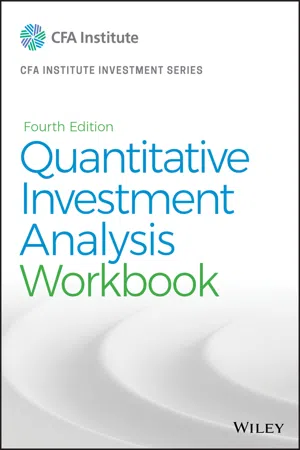
- English
- ePUB (mobile friendly)
- Available on iOS & Android
About this book
The thoroughly revised and updated fourth edition of the companion workbook to Quantitative Investment Analysis is here.
Now in its fourth edition, the Quantitative Investment Analysis Workbook offers a range of practical information and exercises that will facilitate your mastery of quantitative methods and their application in today's investment process. Part of the reputable CFA Institute Investment Series, the workbook is designed to further your hands-on experience with a variety of learning outcomes, summary overview sections, and challenging problems and solutions.
The workbook provides all the statistical tools and latest information to help you become a confident and knowledgeable investor, including expanded problems on Machine Learning algorithms and the role of Big Data in investment contexts. Well suited for motivated individuals who learn on their own, as well as a general reference, this companion resource delivers a clear, example-driven method for practicing the tools and techniques covered in the primary Quantitative Investment Analysis, 4th Edition text.?? Inside you'll find information and exercises to help you:
- Work real-world problems associated with the modern quantitative investment process
- Master visualizing and summarizing data
- Review the fundamentals of single linear and multiple linear regression
- Use multifactor models
- Measure and manage market risk effectively
In both the workbook and the primary Quantitative Investment Analysis, 4th Edition text, the authors go to great lengths to ensure an even treatment of subject matter, consistency of mathematical notation, and continuity of topic coverage that is critical to the learning process.
For everyone who requires a streamlined route to mastering quantitative methods in investments, Quantitative Investment Analysis Workbook, 4th Edition offers world-class practice based on actual scenarios faced by professionals every day.
Frequently asked questions
- Essential is ideal for learners and professionals who enjoy exploring a wide range of subjects. Access the Essential Library with 800,000+ trusted titles and best-sellers across business, personal growth, and the humanities. Includes unlimited reading time and Standard Read Aloud voice.
- Complete: Perfect for advanced learners and researchers needing full, unrestricted access. Unlock 1.4M+ books across hundreds of subjects, including academic and specialized titles. The Complete Plan also includes advanced features like Premium Read Aloud and Research Assistant.
Please note we cannot support devices running on iOS 13 and Android 7 or earlier. Learn more about using the app.
Information
PART I
LEARNING OBJECTIVES, SUMMARY OVERVIEW, AND PROBLEMS
CHAPTER 1
THE TIME VALUE OF MONEY
LEARNING OUTCOMES
- interpret interest rates as required rates of return, discount rates, or opportunity costs;
- explain an interest rate as the sum of a real risk-free rate and premiums that compensate investors for bearing distinct types of risk;
- calculate and interpret the effective annual rate, given the stated annual interest rate and the frequency of compounding;
- solve time value of money problems for different frequencies of compounding;
- calculate and interpret the future value (FV) and present value (PV) of a single sum of money, an ordinary annuity, an annuity due, a perpetuity (PV only), and a series of unequal cash flows;
- demonstrate the use of a time line in modeling and solving time value of money problems.
SUMMARY
- The interest rate, r, is the required rate of return; r is also called the discount rate or opportunity cost.
- An interest rate can be viewed as the sum of the real risk-free interest rate and a set of premiums that compensate lenders for risk: an inflation premium, a default risk premium, a liquidity premium, and a maturity premium.
- The future value, FV, is the present value, PV, times the future value factor, (1 + r)N.
- The interest rate, r, makes current and future currency amounts equivalent based on their time value.
- The stated annual interest rate is a quoted interest rate that does not account for compounding within the year.
- The periodic rate is the quoted interest rate per period; it equals the stated annual interest rate divided by the number of compounding periods per year.
- The effective annual rate is the amount by which a unit of currency will grow in a year with interest on interest included.
- An annuity is a finite set of level sequential cash flows.
- There are two types of annuities, the annuity due and the ordinary annuity. The annuity due has a first cash flow that occurs immediately; the ordinary annuity has a first cash flow that occurs one period from the present (indexed at t = 1).
- On a time line, we can index the present as 0 and then display equally spaced hash marks to represent a number of periods into the future. This representation allows...
Table of contents
- Cover
- Title Page
- Copyright
- CONTENTS
- PART I: LEARNING OBJECTIVES, SUMMARY OVERVIEW, AND PROBLEMS
- PART II: SOLUTIONS
- ABOUT THE CFA PROGRAM
- END USER LICENSE AGREEMENT